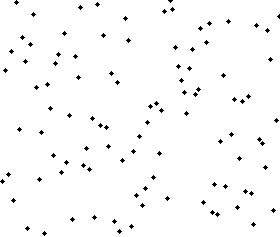归并排序(Merge sort)是创建在归并操作上的一种有效的排序算法。该算法是采用分治法(Divide and Conquer)的一个非常典型的应用。

一个归并排序的例子:对一个随机点的链表进行排序
算法描述
归并操作的过程如下:
- 申请空间,使其大小为两个已经排序序列之和,该空间用来存放合并后的序列
- 设定两个指针,最初位置分别为两个已经排序序列的起始位置
- 比较两个指针所指向的元素,选择相对小的元素放入到合并空间,并移动指针到下一位置
- 重复步骤3直到某一指针到达序列尾
- 将另一序列剩下的所有元素直接复制到合并序列尾
特点:归并排序是稳定的排序.即相等的元素的顺序不会改变, 速度仅次于快速排序,但较稳定。
归并操作
归并操作(merge),也叫归并算法,指的是将两个顺序序列合并成一个顺序序列的方法。
如:设有数列 [6,202,100,301,38,8,1]
初始状态:6, 202, 100, 301, 38, 8, 1
第一次归并后:[6, 202], [100, 301], [8, 38], [1],比较次数:3;
第二次归并后:[6, 100, 202, 301],[1, 8, 38],比较次数:4;
第三次归并后:[1, 6, 8, 38, 100, 202, 301],比较次数:4;
总的比较次数为:3+4+4=11,;
逆序数为14;
算法实现
|
1
2
3
4
5
6
7
8
9
10
11
12
13
14
15
16
17
18
19
20
21
22
23
24
25
26
27
28
29
30
31
32
33
34
35
36
37
38
39
40
41
42
43
44
45
46
47
48
49
50
51
52
53
54
55
56
57
|
// Completed on 2014.10.11 17:20// Language: C99//// 版权所有(C)codingwu (mail: oskernel@126.com) // 博客地址:http://www.cnblogs.com/archimedes/#include<stdio.h>#include<stdlib.h>void merge_sort(int *list, const int first, const int last){ int len= last-first+1; int left_min,left_max; //左半区域边界 int right_min,right_max; //右半区域边界 int index; int i; int *tmp; tmp = (int *)malloc(sizeof(int)*len); if( tmp == NULL || len <= 0 ) return; for( i = 1; i < len; i *= 2 ) { for( left_min = 0; left_min < len - i; left_min = right_max) { int j; right_min = left_max = left_min + i; right_max = left_max + i; j = left_min; if ( right_max > len ) right_max = len; index = 0; while( left_min < left_max && right_min < right_max ) { tmp[index++] = (list[left_min] > list[right_min] ? list[right_min++] : list[left_min++]); } while( left_min < left_max ) { list[--right_min] = list[--left_max]; } while( index > 0 ) { list[--right_min] = tmp[--index]; } } } free(tmp);}int main(){ int a[] = {288, 52, 123, 30, 212, 23, 10, 233}; int n, mid; n = sizeof(a) / sizeof(a[0]); mid = n / 2; merge_sort(a, 0, n - 1); for(int k = 0; k < n; k++) printf("%d ", a[k]); printf("\n"); return 0;} |
使用递归实现:
|
1
2
3
4
5
6
7
8
9
10
11
12
13
14
15
16
17
18
19
20
21
22
23
24
25
26
27
28
29
30
31
32
33
34
35
36
37
38
39
40
41
42
43
44
45
46
47
48
49
50
51
52
53
54
55
56
57
58
59
60
61
62
63
64
65
66
67
68
69
70
|
// Completed on 2014.10.11 18:20// Language: C99//// 版权所有(C)codingwu (mail: oskernel@126.com) // 博客地址:http://www.cnblogs.com/archimedes/#include<stdio.h>#include<stdlib.h>void merge(int *array,const int first, const int mid, const int last){ int i,index; int first1,last1; int first2,last2; int *tmp; tmp = (int *)malloc((last-first+1)*sizeof(int)); if( tmp == NULL ) return; first1 = first; last1 = mid; first2 = mid+1; last2 = last; index = 0; while( (first1 <= last1) && (first2 <= last2) ) { if( array[first1] < array[first2] ) { tmp[index++] = array[first1]; first1++; } else{ tmp[index++] = array[first2]; first2++; } } while( first1 <= last1 ) { tmp[index++] = array[first1++]; } while( first2 <= last2 ) { tmp[index++] = array[first2++]; } for( i=0; i<(last-first+1); i++) { array[first+i] = tmp[i]; } free(tmp);}void merge_sort(int *array, const int first, const int last){ int mid = 0; if(first < last) { mid = (first + last) / 2; merge_sort(array, first, mid); merge_sort(array, mid + 1, last); merge(array, first, mid, last); }}int main(){ int a[] = {288, 52, 123, 30, 212, 23, 10, 233}; int n, mid; n = sizeof(a) / sizeof(a[0]); mid = n / 2; merge_sort(a, 0, n - 1); for(int k = 0; k < n; k++) printf("%d ", a[k]); printf("\n"); return 0;} |
感谢阅读,希望能帮助到大家,谢谢大家对本站的支持!














